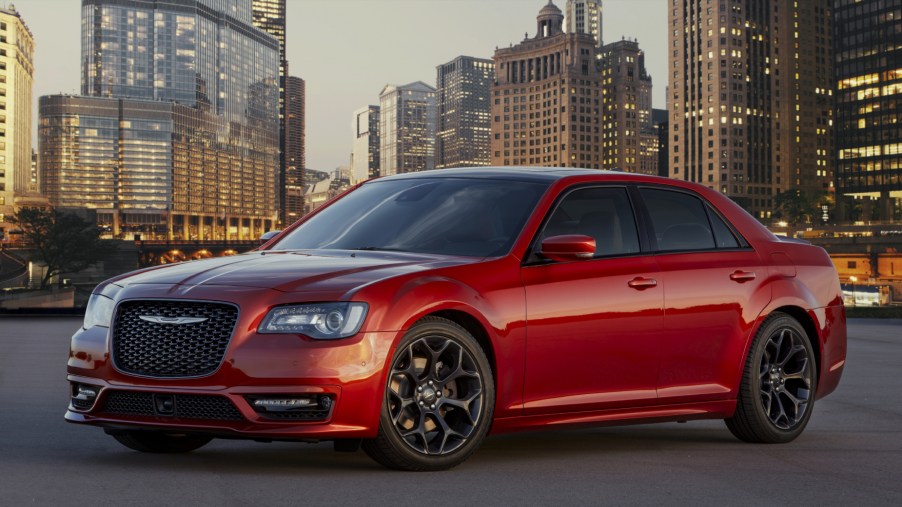
Not Done Yet: FCA To Produce Chrysler 300 for at Least 3 More Years
The Chrysler 300 is a throwback to a different era. This sophisticated large sedan commands respect from onlookers with its elegant profile highlighted by Chrysler’s bold signature grille.
While this car undoubtedly makes a statement, it no longer resonates with modern car buyers. This full-size sedan initially debuted in February 2004, and it was last redesigned for the 2011 model year. However, the 300 hasn’t made many changes over the past few years, aside from the addition of crucial safety and connective technologies.
Rumors have swirled for years now that Fiat Chrysler Automobiles (FCA) will discontinue or redesign the Chrysler 300. However, a recent CNET report quieted the noise, as the publication speculates the 300’s current platform will live on through 2024.
What’s the background behind the latest news of the 300, and what may the future look like for this iconic full-size sedan? Let’s take an in-depth look at FCA’s latest developments to learn more.
FCA keeps its classics alive while investing in the future

Like many American vehicles, the Chrysler 300 is built outside of the United States. However, you wouldn’t have to travel far to see one on the production line. The 300 is assembled in Brampton, Ontario, which is only an hour and a half away from Buffalo, NY.
FCA announced via a press release that the Chrysler 300’s production will remain in Brampton. This news is part of a broader three-year financial agreement with Unifor, a Canadian automotive labor union. This deal includes an investment of up to 1.58 billion Canadian dollars in the manufacturing operation, as well as the creating of 2,000 jobs.
A significant part of this expenditure is to develop electric vehicles and plug-in hybrid (PHEV) models. Currently, the Pacifica Hybrid minivan is Chrysler’s only eco-friendly offering in the United States.
Meanwhile, FCA put CA$50 billion toward the continued production of the Chrysler 300, as well as the Dodge Charger and Dodge Challenger.
The Chrysler 300 is the gentleman’s sedan
To say that the Chrysler 300 is dated isn’t necessarily a negative remark. The 2021 300 is exceptionally spacious, powerful, and upscale. With a starting MSRP of $30,040, this model floats between the classification of standard and luxury. It’s more well-appointed than its rivals, and it could easily be confused for a Cadillac.
However, it lags behind economy cars in driver-assistance technologies, which is likely why it’s so affordably priced. Most of its safety systems, such as automatic emergency braking, come at an added cost. These cutting-edge technologies have become more important to shoppers in recent years, and this coincides with declining sales of the Chrysler 300.
According to GoodCarBadCar.com, the Chrysler 300 had steady sales above 50,000 units between 2012 and 2017. However, these figures began to dip in 2018, falling to 46,593 sales, and it completely plummeted in 2019, with only 29,214 Chrysler 300s sold.
Meanwhile, Chrysler slashed the 300’s trims down to just three – Touring, Touring L, and 300S. The Touring and Touring L are powered by a 300-hp 3.6-liter V6 engine and an eight-speed automatic transmission. The 300S kicks the performance up a notch with a 5.7-liter V8 engine, which delivers 363 hp and 394 lb-ft of torque.
This rear-wheel-drive sedan’s power comes at a cost. The 2020 Chrysler 300 only achieved an EPA-estimated 23 MPG city/highway combined with its V6 engine, and V8-equipped models only earned 19 MPG combined.
What’s next for the Chrysler 300?
Hybrids and electric vehicles are the future, so FCA must either make the Chrysler 300 get with the times or get lost. This shift in the industry opens up an opportunity for Chrysler, as the 300 branding holds weight as a prestigious car.
FCA might want to consider carrying over the Chrysler 300 if it uses its large investment toward building a plug-in hybrid or EV sedan. Here’s to hoping that a redesigned, eco-friendly 300 emerges following 2024.


